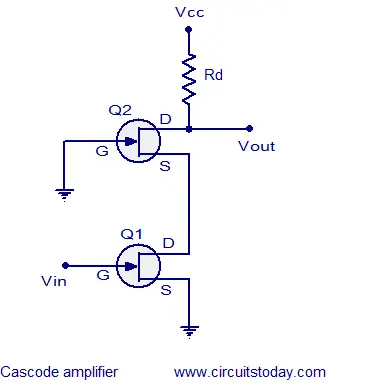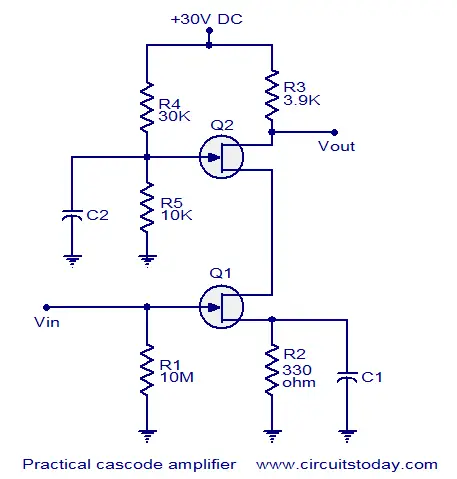Cascode amplifier is a two stage circuit
consisting of a transconductance amplifier followed by a buffer
amplifier. The word “cascode” was originated from the phrase “cascade to
cathode”. This circuit have a lot of advantages over the single stage
amplifier like, better input output isolation, better gain, improved
bandwidth, higher input impedance, higher output impedance, better
stability, higher slew rate etc. The reason behind the increase in
bandwidth is the reduction of Miller effect. Cascode amplifier
is generally constructed using FET ( field effect transistor) or BJT (
bipolar junction transistor). One stage will be usually wired in common
source/common emitter mode and the other stage will be wired in common
base/ common emitter mode.
Miller effect.
Miller effect is actually the
multiplication of the drain to source stray capacitance by the voltage
gain. The drain to source stray capacitance always reduces the bandwidth
and when it gets multiplied by the voltage gain the situation is made
further worse. Mulitiplication of stray capacitance increases the
effective input capacitance and as we know, for an amplifier, the
increase in input capacitance increases the lower cut of frequency and
that means reduced bandwidth. Miller effect can be reduced by adding a
current buffer stage at the output of the amplifier or by adding a
voltage buffer stage before the input.
FET Cascode amplifier.
The circuit diagram of a typical Cascode
amplifier using FET is shown above. The input stage of the circuit is
an FET common source amplifier and the input voltage (Vin) is applied to
its gate. The output stage is an FET common gate amplifier which is
driven by the input stage. Rd is the drain resistance of the output
stage. Output voltage (Vout) is taken from the drain terminal of Q2.
Since the gate of Q2 is grounded, FET Q2′s source voltage and the FET
Q1′s drain voltage are held almost constant. That means the upper FET Q2
offers a low input resistance to the lower FET Q1. This reduces the
gain of lower FET Q1 and as a result the Miller effect also gets reduced
which results in increased bandwidth. The reduction in gain of the
lower FET Q1 does not affect the overall gain because the upper FET Q2
compensates it. The upper FET Q2 is not affected by the Miller effect
because the charging and discharging of the drain to source stray
capacitance is carried out through the drain resistor and the load and
the frequency response if affected only for high frequencies (well over
the audio range).
In Cascode configuration, the output is
well isolated from the input. Q1 has almost constant voltage at the
drain and source terminals while Q2 has almost constant voltage at its
source and gate terminals and practically there is nothing to feed back
from the output to input. The only points with importance in terms of
voltage are the input and output terminals and they are well isolated by
a central connection of constant voltage.
Practical Cascode amplifier circuit.
A practical Cascode amplifier circuit based on FET is shown above. Resistors R4 and R5 form a voltage divider biasing network for the FET Q2. R3 is the drain resistor for Q2 and it limits the drain current. R2 is the source resistor of Q1 and C1 is its by-pass capacitor. R1 ensures zero voltage at the gate of Q1 during zero signal conditionsource:circuitstoday.com
Share this on your favourite network









you are clear my mind actually after reading your article i got clear my complete doubt. thanks for such easy understanding post. Sharing on advantages of fet for future aspect at here http://electrotopic.com/what-are-the-advantages-of-fet-over-transistor/
ReplyDelete